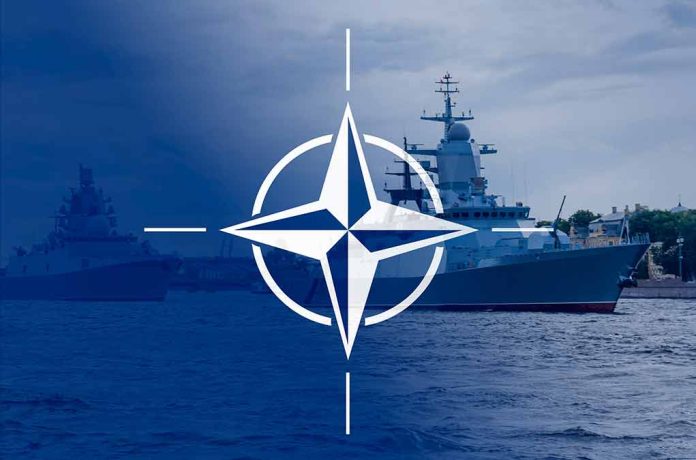
Trump’s demands for increased NATO defense spending to 5% of GDP gain traction as US Defense Secretary Pete Hegseth tells NATO allies they “cannot rely on the United States to defend them” ahead of a crucial summit in the Netherlands.
Key Takeaways
- US Defense Secretary Pete Hegseth is pushing NATO allies to increase defense spending to 5% of GDP, aligning with President Trump’s longstanding demands for fair burden-sharing.
- NATO Chief Mark Rutte has proposed a compromise of 3.5% for core military spending plus 1.5% for broader security by 2032, meeting resistance from several European nations.
- Germany faces pressure to add up to 60,000 soldiers to meet new capability targets for deterring Russia, while Spain remains reluctant to commit to higher spending levels.
- Uncertainty looms over the upcoming NATO summit regarding Ukraine’s participation and continued US commitment to European defense as America potentially shifts focus toward China.
America Demands NATO Self-Sufficiency
Defense Secretary Pete Hegseth delivered a clear message to NATO allies during meetings in Brussels this week: the era of European dependence on American military might must end. Speaking ahead of the critical NATO summit scheduled for June 24-25 in the Netherlands, Hegseth reinforced President Trump’s longstanding position that European nations must dramatically increase their defense spending and capabilities to ensure collective security. The timing of this push is significant as NATO grapples with ongoing security challenges from Russia and the continuing conflict in Ukraine.
“NATO allies cannot rely on the United States to defend them and need to step up themselves,” said Pete Hegseth, US Defense Secretary.
The 5% Target: Trump’s Vision for NATO
President Trump has been unwavering in his call for NATO members to significantly boost defense spending. His administration is now formally pushing for a 5% of GDP target, more than double the current 2% commitment that many alliance members still struggle to meet. This aggressive target represents the Trump doctrine of “peace through strength” while ensuring that America isn’t carrying a disproportionate burden of NATO’s defense responsibilities. The proposed increase comes as Russia’s continued aggression in Ukraine has exposed critical capability gaps within European defense structures.
“The United States is proud to be here, to stand with our allies, but our message is gonna continue to be clear: It’s deterrence and peace through strength, but it cannot be reliance,” stated Pete Hegseth, US Defense Secretary.
The Trump administration’s stance reflects growing frustration with European reluctance to invest adequately in their own defense capabilities. US Ambassador to NATO Matthew Whitaker emphasized that NATO’s Article 3, which requires members to build capacity to resist armed attacks, is equally important as the more frequently cited Article 5 mutual defense clause. This represents a fundamental shift in how the administration views alliance obligations – not just as promises of American protection but as commitments to shared defense responsibility.
European Resistance and Rutte’s Compromise
NATO Secretary General Mark Rutte has attempted to navigate between American demands and European hesitation by proposing a compromise: 3.5% of GDP devoted to core military spending with an additional 1.5% allocated to broader security sectors by 2032. This framework would theoretically satisfy Trump’s 5% target while giving European nations more flexibility in how they categorize defense-related expenditures. However, this proposal has received mixed reception among NATO members, with diplomatic negotiations ongoing to extend implementation timelines.
“It cannot and will not be reliance on America. It can’t just be U.S. capabilities,” emphasized Pete Hegseth, US Defense Secretary.
Spain has emerged as particularly resistant to increased spending commitments, only expected to reach the current 2% target by year’s end. Meanwhile, Germany faces significant pressure to expand its military forces by 50,000-60,000 soldiers to meet new capability targets aimed at deterring Russia. This demonstrates the practical challenges of translating percentage-based spending targets into actual military capabilities that address NATO’s strategic needs. The disparity in commitment levels threatens to create further divisions within an alliance already strained by divergent security priorities.
Summit Challenges: Ukraine’s Role and America’s Focus
The upcoming NATO summit faces additional complications regarding Ukraine’s participation and the future of alliance support for its war effort against Russia. While there is pressure to invite President Volodymyr Zelenskyy as a show of solidarity, his attendance remains unconfirmed. This uncertainty reflects broader questions about NATO’s long-term strategy toward Ukraine and how the alliance will sustain support for Kyiv amid competing global priorities. President Trump has consistently called for European nations to take greater responsibility for Ukraine’s defense needs.
Another shadow looming over the summit is the potential reallocation of American military resources away from Europe toward the Indo-Pacific region to counter China’s growing influence. This strategic pivot, long signaled by American defense planners, underscores the urgency of European defense self-sufficiency. As NATO ministers approve new capability targets specifically designed to deter Russia, the alliance must reconcile with the reality that American forces may not always be available in the numbers European security has historically relied upon, making President Trump’s calls for increased European defense spending all the more critical.






